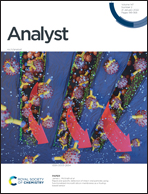MOF-assisted antifouling material: application in rapid determination of TB gene in whole-serum specimens†
Abstract
Biofouling is a nuisance in the practical applications of biosensors, which seriously affects the reliability and accuracy of detection. The utilization of antifouling interface materials is a promising option for mitigating biofouling. Only highly accumulated antifouling polymeric surfaces tend to offer “zero” nonspecific protein adsorption. Herein, superior antifouling coatings based on chondroitin sulfate (CS) were prepared by the NH2-MIL-53 (Al) assisted strategy. This is a novel design to improve the antifouling property of material by taking advantage of the high specific surface area of the three-dimensional MOF to increase the accumulation degree of antifouling functional groups per unit area. And the related chemical technology is simple and easy to operate. As expected, this novel CS-loaded MOF demonstrated an excellent antifouling performance in various biological samples, even in 100% goat serum. Only 8.48% changes of differential pulse voltammetry (DPV) were found. Furthermore, this antifouling interface material is successfully applied for the specific detection of the tuberculosis (TB) gene in undiluted biofluids. This developed TB biosensor showed a high analytical performance with a wide linear range (1.00 × 10−16 M to 1.00 × 10−11 M) and a low detection limit, indicating that it may open new avenues for direct biosensing of disease markers for clinical samples.



 Please wait while we load your content...
Please wait while we load your content...